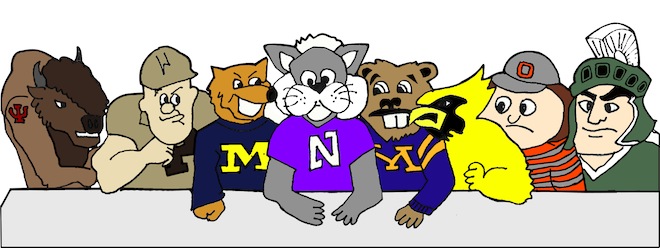
Nerds can’t be good at sports. That’s how it’s always been. Pocket protectors and pocket passers aren’t found in the same places. Sure, Northwestern’s recent success on the gridiron and lacrosse field might suggest otherwise, but academic standards and athletic success usually just don’t mesh.
The Wildcat football teams of the late 1970s were prime examples. These teams weren’t just bad. They were awful. And constant failure caused some to question Northwestern’s Big Ten membership.
As ESPN College GameDay’s production trucks rolled onto Northwestern’s campus for an Oct. 5 matchup with the third-ranked Ohio State Buckeyes, Evanston became the center of the college football universe. Thirty years ago, Northwestern students would never have thought this possible. Long before Pat Fitzgerald led the ‘Cats to the Rose Bowl as a player following the 1995 season and to victory in the Gator Bowl as a coach, Northwestern’s football program was the laughingstock of the nation.
With the 1949 Rose Bowl victory ancient history, the 1970s were a dark time for Northwestern football. Led by coaches John Pont (1973-1977) and Rick Venturi (1978-1980), the Wildcats struggled to an abysmal 13-74-1 record over the course of eight seasons. In 1977, a fan in the stands held up a sign that read “Mom: I don’t need money. Send a team.” But even these horror stories hardly illustrate how bad the Wildcats were about to become. After a Sept. 15, 1979 win over Wyoming, the Wildcats lost their next 34 games, a national record that still stands today.
Before Dennis Green—the Big Ten’s first African-American head football coach—finally led Northwestern to a 31-6 win against NIU in 1982, the Wildcats didn’t manage a victory for three whole years.
A 61-14 pasting at the hands of Michigan State in 1981 marked Northwestern’s 29th consecutive loss, which set a new NCAA record for futility. Without a winning team to support, Northwestern fans began chanting, “We’re the worst!” The Wildcats were outscored 505-32 that season. At one point, someone altered an Interstate 94 sign by painting “Northwestern 0” underneath the original lettering, poking fun at the ‘Cats with a fake boxscore.
Surprisingly, the administration didn’t seem too concerned. Though former University President Robert H. Strotz fired athletic director John Pont and head coach Rick Venturi after the 1980 season, he had previously made comments implying the football program wasn’t a priority for the University.
“I think having a bad football team can help academic standards,” Strotz said, according to Larry LaTourette’s book Northwestern Wildcat Football.
The road to recovery was difficult, and at one point the athletic director even alluded to the eventual possibility of the ‘Cats leaving the Big Ten.
“It will take three to five years—and I really believe it will take us that long—before we can move from a non-competitive status to a competitive status and win three to five games a year,” Northwestern athletic director Doug Single said in October 1981. “Getting out of the Big Ten should not be an option unless and until five years from now we can’t compete on a Big Ten level in football and [men’s] basketball.”
Opinions like Strotz’s caused Northwestern to at least weigh the option of departing the Big Ten. One thing was certain, though: Northwestern wouldn’t compromise its academic standards to win games. Prominent alum Mike Wilbon was among those to protest such a strategy.
“I’m sick of hearing you say...that Northwestern has to lower its requirements to admit first-rate student athletes. Lies. Lies. Lies,” Wilbon wrote in a letter to the school.
And, ultimately, Wilbon was right. Northwestern continued to struggle for years. But the Wildcats recovered. The ‘Cats wouldn’t accomplish anything spectacular until the 1995 Rose Bowl season, but their improvement was noteworthy. After a 34-game losing steak, almost anything constitutes noteworthy improvement.
As the students piled behind the GameDay set in 2013, it’s likely none of this crossed their minds. For those old enough to remember the dark ages, however, these recent successes mean just a little bit more.